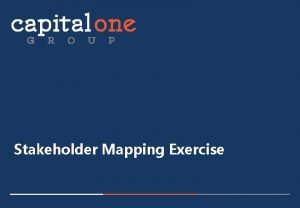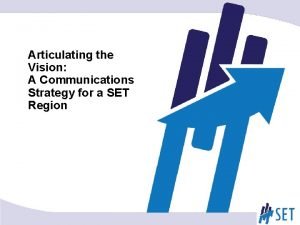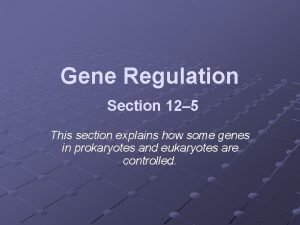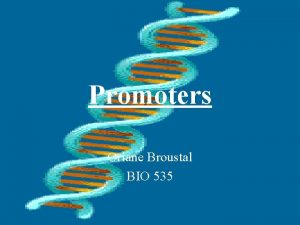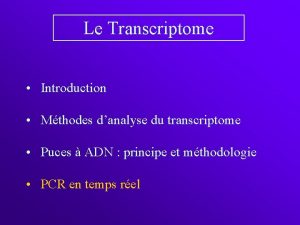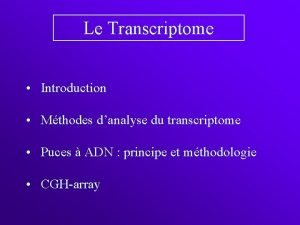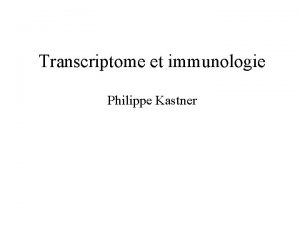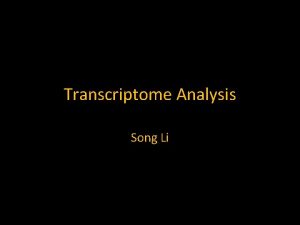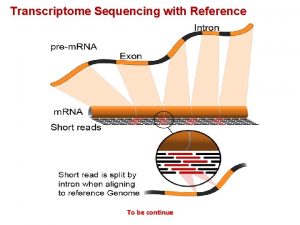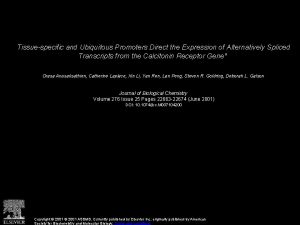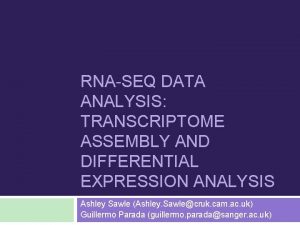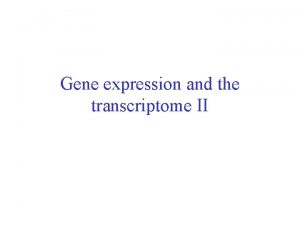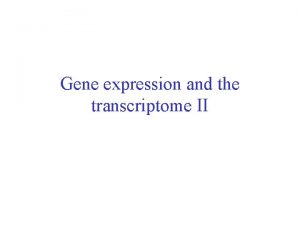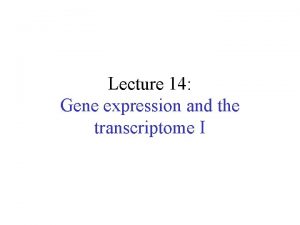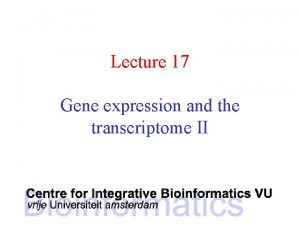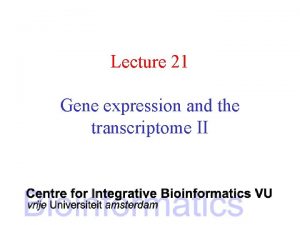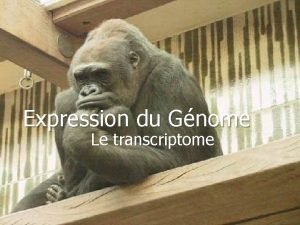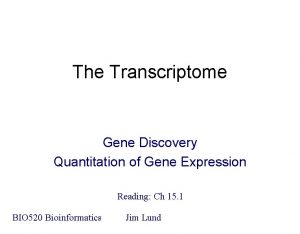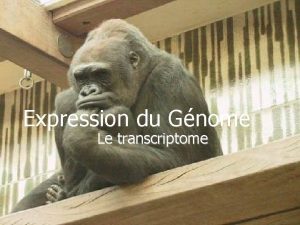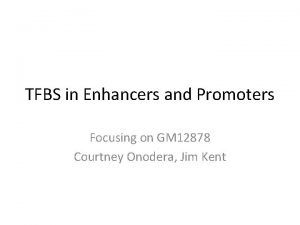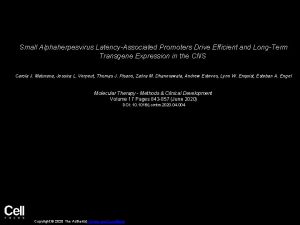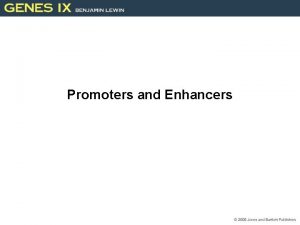Transcriptome PROMOTERS AND EXPRESSION The transcriptome transcriptome is













































- Slides: 45

Transcriptome PROMOTERS AND EXPRESSION

The transcriptome �transcriptome is the set of all RNA molecules �Including: qm. RNA qr. RNA qt. RNA qother non-coding RNA

Outline �Measuring gene expression levels �New understandings of promoters directionality

Motivation �Question: How can we measure protein levels in the body? �The current way to measure was to look at genes expression levels But… �New understandings show that we should measure each of the genes isoforms separately

We would like to… 1. Compare between expression levels of different genes 2. Compare between expression levels of different isoforms of a single gene

Different isoforms of one gene Gene A Isoform 1 Isoform 2

RNA-seq: reminder CCGAT T G AG

What’s after RNA-seq? �We will describe two different methods to approximate the gene expression Union count Intersect count

Union Count �counts reads falling on any of a gene’s exons Isoform 1 Isoform 2 Gene A �What could be the problems? Gene B

Intersect Count �Counts only reads on exons shard by all isoforms Isoform 1 Isoform 2 Gene A

Two main problems �How can we compare between isoforms of the same gene? �What about the length of the gene?

Cuffdiff 2 – Cole Trapnell Change #1: Assign each fragment to a specific isoform Change #2: Normalize the number of fragments assigned to each isoform by its length

Assigning fragments to isoforms Isoform 1 Isoform 2 Isoform 3 Basic Assumption: Percentage of fragments belonging to each isoform is uniform

Assigning fragments to isoforms Isoform 1 Isoform 2 Isoform 3

Cuffdiff 2 vs. old methods

Cuffdiff 2 vs. old methods

Cuffdiff 2 vs. old methods

Cuffdiff 2 vs. old methods

Outline �Measuring gene expression levels �New understandings of promoters directionality

Transcription as we know it

Antisense upstream RNA �Antisense transcripts are transcribed from the strand opposite to that of the sense transcript �It can be of either protein-coding or nonprotein- coding genes

au. RNA - Promoters �Antisense upstream transcripts can arise from different kinds of promoters: Bidirectional promoters Cryptic promoters

au. RNA - Characteristics • • Aside from their antisense orientation, they do not have unique features They lack of protein - coding potential Can contain specific domains that interact with DNA, RNA or proteins (like many nc. RNAs) Many of them carry out specific functions

So which strand is the downstream direction? And where are those antisense transcripts?

A new approach Christopher B. Burge Phillip A. Sharp MIT

ua. RNAs do not elongate efficiently �Two potential mechanisms: Inefficient release of paused RNAP 2 Early termination of transcription

Early termination? �It was found that upstream antisense region has a higher number of cleavage sites compared to the downstream sense sites

Unique cleavage sites flanking TSS

Cleavage sites – reminder

The first step �Determine whether members of the canonical cleavage machinery bind to ua. RNAs �Ten 3’ end processing factors were analyzed to find protein – RNA interactions (CLIP method)

�Specific binding of all ten factors was detected at ua. RNA cleavage sites �The positional profiles identical or very similar to that of m. RNA cleavage sites

Understanding the molecular mechanism So, how come there are 2 times the cleavage areas in the upstream direction?

Understanding the molecular mechanism Examine PAS frequencies!

33% depletion of PAS downstream of TSS

Sense genes exhibit large amount of U 1 sites

The U 1 -PAS model U 1 sn. RNP complex suppresses cleavage and polyadenylation near a U 1 site

The U 1 -PAS model


au. RNA – Mechanisms of gene regulation �We will discuss the different steps: Effects on transcription initiation Effects on transcription elongation Post transcriptional effects

Transcription initiation �LUC 7 L produces an antisense transcripts �This transcript overlaps with HBA 1 �It methylates its promoter �HBA 1’s expression is silenced

Transcription elongation �A collision can occur between two RNA polymerases �Can lead to alternative isoforms (independent from splicing mechanisms)

Post transcriptional �The antisense transcript of Uchl 1 binds to the 5’ UTR of the sense transcript �The SINEB 2 domain of the antisense molecule increases Uchl 1 translation efficiency �Two differences from previous examples: Positive effect Mechanism after the antisense is transcribed

Post transcriptional

Summary �New technologies enable us to further understand genes expression levels �Transcription process is not as “simple” as we thought �Every transcript has its role

Questions ?
 Cook tourism
Cook tourism Keep satisfied manage closely monitor keep informed
Keep satisfied manage closely monitor keep informed Articulating a vision
Articulating a vision Eukaryotic promoters are usually found just
Eukaryotic promoters are usually found just Chapter 8 employment labor and wages
Chapter 8 employment labor and wages Quadratic formula
Quadratic formula Hát kết hợp bộ gõ cơ thể
Hát kết hợp bộ gõ cơ thể Frameset trong html5
Frameset trong html5 Bổ thể
Bổ thể Tỉ lệ cơ thể trẻ em
Tỉ lệ cơ thể trẻ em Voi kéo gỗ như thế nào
Voi kéo gỗ như thế nào Chụp tư thế worms-breton
Chụp tư thế worms-breton Alleluia hat len nguoi oi
Alleluia hat len nguoi oi Môn thể thao bắt đầu bằng chữ f
Môn thể thao bắt đầu bằng chữ f Thế nào là hệ số cao nhất
Thế nào là hệ số cao nhất Các châu lục và đại dương trên thế giới
Các châu lục và đại dương trên thế giới Cong thức tính động năng
Cong thức tính động năng Trời xanh đây là của chúng ta thể thơ
Trời xanh đây là của chúng ta thể thơ Mật thư tọa độ 5x5
Mật thư tọa độ 5x5 101012 bằng
101012 bằng Phản ứng thế ankan
Phản ứng thế ankan Các châu lục và đại dương trên thế giới
Các châu lục và đại dương trên thế giới Thể thơ truyền thống
Thể thơ truyền thống Quá trình desamine hóa có thể tạo ra
Quá trình desamine hóa có thể tạo ra Một số thể thơ truyền thống
Một số thể thơ truyền thống Cái miệng xinh xinh thế chỉ nói điều hay thôi
Cái miệng xinh xinh thế chỉ nói điều hay thôi Vẽ hình chiếu vuông góc của vật thể sau
Vẽ hình chiếu vuông góc của vật thể sau Thế nào là sự mỏi cơ
Thế nào là sự mỏi cơ đặc điểm cơ thể của người tối cổ
đặc điểm cơ thể của người tối cổ V cc cc
V cc cc Vẽ hình chiếu đứng bằng cạnh của vật thể
Vẽ hình chiếu đứng bằng cạnh của vật thể Tia chieu sa te
Tia chieu sa te Thẻ vin
Thẻ vin đại từ thay thế
đại từ thay thế điện thế nghỉ
điện thế nghỉ Tư thế ngồi viết
Tư thế ngồi viết Diễn thế sinh thái là
Diễn thế sinh thái là Dot
Dot Các số nguyên tố
Các số nguyên tố Tư thế ngồi viết
Tư thế ngồi viết Lời thề hippocrates
Lời thề hippocrates Thiếu nhi thế giới liên hoan
Thiếu nhi thế giới liên hoan ưu thế lai là gì
ưu thế lai là gì Hổ sinh sản vào mùa nào
Hổ sinh sản vào mùa nào Sự nuôi và dạy con của hươu
Sự nuôi và dạy con của hươu Hệ hô hấp
Hệ hô hấp

